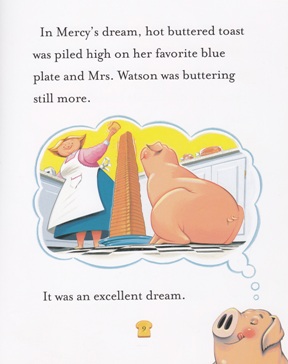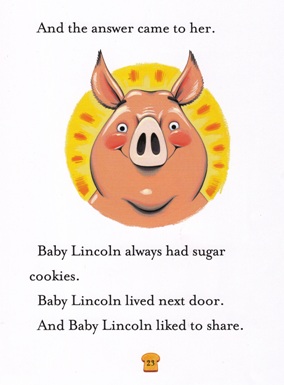Before I start my discussion of Mercy Watson to the Rescue – which, by the way, is an exceptionally good book – I’m going to get into an annoyingly pedantic discussion of children’s book categories. Why? Because one big part of collecting books for your child is figuring out what books are appropriate for your kid at what age.
And I’m not talking about subject matter. Generally, you don’t have to worry about boobs, blood, and salty language until you get into later-age YA fiction. (Unless there are some really awesome picture books that no one has turned me onto yet. Clue me in, guys. I’m cool.) I’m talking about format – how many pages, what’s the text-to-picture ratio, how big is the font, how long is the story, etc. Different formats work best at different stages along your child’s development as a reader. There are lots of categories and terms for these books – some are used often, some less so, some are interchangeable, some are used incorrectly… it can be a huge pain. (If you’re really not interested in reading a brief aside about children’s book types, scan down a bit and I’ll say “BORING PART OVER” when I’m done.)
There are easy readers (sometimes called “I Can Read” books), beginning readers, middle readers, transitional readers, chapter books, young adult books – the list goes on and on. Since my daughter is almost five, we’ve had limited interaction with some of these book types so far, particularly the ones above her current reading level. We have TONS of picture books. (Almost literally tons.) Over the past year, we’ve spent a lot of time getting comfortable with easy readers. And we even have a few younger-skewing YA novels (mostly the works of Roald Dahl) that we’ve read aloud during bedtimes (plus whole shelves of YA novels that can be classified under the “Books My Kid Will One Day Read” category).
If I had to pick a category that we’ve explored the least so far, it’d be chapter books, but I bet that’s going to change a lot over the next year. Chapter books are story-books that are normally targeted at 6 to 10 year olds, and they’re sort of mini large-print novels. They’re short novellas with a relatively large font size and a much higher emphasis on text than images. (All chapter books have illustrations.) They’re the next step up from easy readers and, typically, they’re broken into frequent chapters to help hold the attention span of the reader and make it easier to check in and out if the reader can’t finish the whole book in a single sitting. (As I describe them, they sound a lot like Dan Brown novels… but better.)
BORING PART OVER! – At the moment, our favorite chapter books come from Kate DiCamillo’s Mercy Watson series, which began with the fantastic Mercy Watson to the Rescue. In the world of chapter books, the Mercy Watson series skews pretty young – Chris Van Dusen produces so many expressive, polished, retro-styled paintings to accompany each book that, at times, they resemble longer picture books – but the stories are so simple yet sophisticated that many different age groups can enjoy the series. An eight-year-old would get a kick out of reading them and, I can attest from past experience, a four-year-old loves having them read to her. A lot of that has to do with Kate DiCamillo’s talent as a writer.
Once you start collecting books for your children – or even regularly checking books out for them at your library – you will very, very quickly start to develop a list of “must-read” authors. These are the authors who are so good so consistently that you’ll find yourself going back to them again and again. We have a couple of must-reads at our house. It’s very hard to go wrong with Mo Willems, Maurice Sendak, Lane Smith, Julia Donaldson, William Steig, Doreen Cronin… the list goes on and on. Kate DiCamillo is definitely on our “must-read” author list too.
We honestly haven’t read a Kate DiCamillo book that we haven’t enjoyed yet. The Mercy Watson series, Bink & Gollie (so good), Louise: The Adventures of a Chicken (maybe in the top 10 of our favorite kids’ books EVER), The Tale of Despereaux, The Magician’s Elephant … all of them have been so reliably fantastic that Kate DiCamillo books have become our literary equivalent of comfort food at this point. If we’re looking to calm down from a long day, we know that a Kate DiCamillo book won’t disappoint. (I should note that DiCamillo has many other famous books that we haven’t gotten to yet – Because of Winn-Dixie, The Miraculous Journey of Edward Tulane – but, trust me, we’ll get to them.)
What makes Kate DiCamillo books so special? I think part of their charm is that DiCamillo often plays with subject matter that, in other hands, might be referred to as “old-fashioned.” But, in DiCamillo’s hands, that material becomes “classic.” She’s just a great storyteller and she knows how to take familiar, iconic stories and relationships and make them seem fresh and new.
In Mercy Watson to the Rescue, we meet Mr. and Mrs. Watson, who live at 54 Deckawoo Drive and have a prized pet pig named Mercy. Mercy is the Watson’s darling, their dear, and her favorite thing in the world is toast with a great deal of butter. After Mercy jumps into bed with the Watsons one night, the bed starts to break through the floor (sleeping with pigs will do that), leaving the Watsons in a precarious position. They send Mercy for help, but, being a pig, Mercy’s rescue mission looks a lot like a hunt for more toast. Fortunately for the Watsons, a grand misunderstanding between the toast-craving Mercy and their pig-hating neighbor, Eugenia Lincoln, eventually escalates to the point where firemen are called to the scene – thankfully, just in time to save the Watsons.
Mercy Watson to the Rescue is a fun book. It’s a caper, a romp. DiCamillo takes little domestic squabbles and problems – a broken bed, an angry neighbor, confused firemen – and turns them into entertaining, self-aware, suburban melodrama. But the melodrama is so cleverly told and so obviously being played for laughs that it’s almost impossible not to love. There’s nothing sarcastic or satirical or meta about the Mercy Watson books. They’re incredibly earnest, but in a very, very smart way and that sense of sincerity makes for a really refreshing read. And I’m happy to say that same sense of absurd domestic fun runs throughout the entire Mercy Watson series.
I can’t think of a better introduction to the chapter book format for kids and these can be really excellent transitional books for your child – I used the word “transitional”… someone needs to smack me – especially if you’re at the point where you think your early reader is ready to sit a little longer and try something a little more plotted than your normal 32-page picture book. Mercy Watson is a porcine wonder and, believe me, you’ll be happy that you gave her a shot.
THE DETAILS ON MERCY WATSON TO THE RESCUE :
AGE RANGE: Kindergarten to second grade (Ages 4-8) is the recommended range. However, this is a very funny book that you can definitely read to kids younger than 4 – attention span allowing.
PAGE COUNT: 80 pages
AUTHOR WEB SITE: Kate DiCamillo has a very nicely organized site, with sample chapters, teachers’ guides, and more. Plus there’s an official Mercy Watson site you can visit too – with games, a guide to Mercy’s neighborhood, info on the series, resources for teachers and parents, and lots of other fun stuff.
BUY IT, BORROW IT, OR FORGET IT?: Buy it. The series is in paperback now, so each volume is really affordable. However, if you’re concerned that your kid isn’t ready to deal with a 60+ page book yet, it might be a good idea to borrow it from your library just to pilot it first.
IF YOU LIKED MERCY WATSON TO THE RESCUE, YOU MIGHT ALSO LIKE:
- Amelia Bedelia by Peggy Parish – The Mercy Watson series doesn’t share the same penchant for wordplay as Parish’s Amelia Bedelia series, but they’re definitely cut from the same cloth. Both series have fun with suburban conventions, have a classic, old-timey feel, can be extremely funny, and create minor, parlor-room comedic-dramas out of overblown misunderstandings. (They also often end similarly – Mercy Watson adventures are normally resolved thanks to a late-night toast snack, while Amelia Bedelia often cures her problems with a judicious helping of lemon meringue pie.)
- Dodsworth in New York by Tim Egan – The Dodsworth books make up another very cool early chapter book series as a dapper mouse named Dodsworth, longing for adventure, sets out on a trip to some of the world’s greatest cities – New York, London, Rome – only to be constantly followed by a crazy duck from his hometown. Duck’s international mischief definitely resembles Mercy’s more domestic mischief and, while the Dodsworth books are definitely more episodic than DiCamillo’s books, they share the same sense of adventure and good-natured exasperation between friends.



{ 1 comment… read it below or add one }
David Small is also a staple in our house.